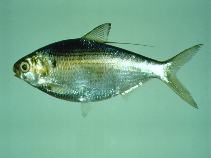| Family: |
Dorosomatidae (Gizzard shads and sardinellas) |
| Max. size: |
27.2 cm TL (male/unsexed) |
| Environment: |
pelagic-neritic; freshwater; brackish; marine; depth range 0 - 30 m, anadromous |
| Distribution: |
Indo-West Pacific: Gulf of Aden north to the Persian Gulf, then eastward to the Andaman Sea, South China Sea and the Philippines, and north to southern tip of Korea. Also reported from Durban Bay in South Africa based on a single juvenile (Ref. 3259). |
| Diagnosis: |
Dorsal spines (total): 0-0; Dorsal soft rays (total): 15-19; Anal spines: 0-0; Anal soft rays: 21-25. Diagnosis: Body rather deep, its depth about 34-41% of standard length, belly with 17-20 + 9-13 scutes, total 28-32 scutes; anterior arm of pre-operculum with the third infra-orbital bone immediately above it, no fleshy gap between; mouth inferior, lower jaw strongly flared outward; last dorsal finray filamentous; pectoral axillary scale present; hind edge of scales distinctly toothed; a dark spot behind gill opening (Ref. 188). Resembles Nematalosa galatheae, which has spots along the flank and a smooth hind edge to scales; Nematalosa arabica, N. come and N. japonica all have a distinct fleshy triangular area above the anterior arm of the pre-operculum and none have toothed scale edges; no other clupeid in the distribution area of Nematalosa nasus has a filamentous dorsal finray (Ref. 188).
Description: Body rather deep, its depth about 34-41% of standard length (Ref. 188). Lower jaw flared outward (Ref. 3259). Gill rakers very numerous, the number increasing with growth (Ref. 3259). Dorsal fin with 3-5 unbranched and 12-14 branched rays, anal fin with 2-3 unbranched and 19-22 branched rays, pectoral fin with 1 unbranched and 12-16 branched rays, pelvic fin with 1 unbranched and 7 branched rays (Ref. 3259). Scales on lateral line 46-49; hind edge of scales toothed in adults (Ref. 3259). With 17-20 pre-pelvic scutes and 9-13 post-pelvic scutes (Ref. 188, 3259).
Colouration: Body and head dark bluish dorsally, silvery below; a dark spot behind gill opening (Ref. 188, 3259). |
| Biology: |
Known from estuaries and coastal areas, occasionally ascending into the upper reaches of the tidal zone (Ref. 12693). A filter-feeder. Marketed fresh, dried-salted or boiled. Made into fish balls. Very bony. |
| IUCN Red List Status: |
Least Concern (LC); Date assessed: 03 December 2019 Ref. (130435)
|
| Threat to humans: |
harmless |
Source and more info: www.fishbase.org. For personal, classroom, and other internal use only. Not for publication.
